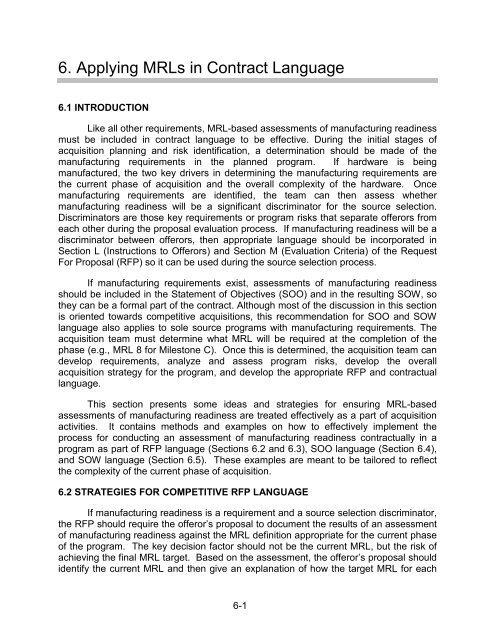Manufacturing Readiness Level (MRL) Deskbook
Manufacturing Readiness Level (MRL) Deskbook
Manufacturing Readiness Level (MRL) Deskbook
- No tags were found...
You also want an ePaper? Increase the reach of your titles
YUMPU automatically turns print PDFs into web optimized ePapers that Google loves.
6. Applying <strong>MRL</strong>s in Contract Language6.1 INTRODUCTIONLike all other requirements, <strong>MRL</strong>-based assessments of manufacturing readinessmust be included in contract language to be effective. During the initial stages ofacquisition planning and risk identification, a determination should be made of themanufacturing requirements in the planned program. If hardware is beingmanufactured, the two key drivers in determining the manufacturing requirements arethe current phase of acquisition and the overall complexity of the hardware. Oncemanufacturing requirements are identified, the team can then assess whethermanufacturing readiness will be a significant discriminator for the source selection.Discriminators are those key requirements or program risks that separate offerors fromeach other during the proposal evaluation process. If manufacturing readiness will be adiscriminator between offerors, then appropriate language should be incorporated inSection L (Instructions to Offerors) and Section M (Evaluation Criteria) of the RequestFor Proposal (RFP) so it can be used during the source selection process.If manufacturing requirements exist, assessments of manufacturing readinessshould be included in the Statement of Objectives (SOO) and in the resulting SOW, sothey can be a formal part of the contract. Although most of the discussion in this sectionis oriented towards competitive acquisitions, this recommendation for SOO and SOWlanguage also applies to sole source programs with manufacturing requirements. Theacquisition team must determine what <strong>MRL</strong> will be required at the completion of thephase (e.g., <strong>MRL</strong> 8 for Milestone C). Once this is determined, the acquisition team candevelop requirements, analyze and assess program risks, develop the overallacquisition strategy for the program, and develop the appropriate RFP and contractuallanguage.This section presents some ideas and strategies for ensuring <strong>MRL</strong>-basedassessments of manufacturing readiness are treated effectively as a part of acquisitionactivities. It contains methods and examples on how to effectively implement theprocess for conducting an assessment of manufacturing readiness contractually in aprogram as part of RFP language (Sections 6.2 and 6.3), SOO language (Section 6.4),and SOW language (Section 6.5). These examples are meant to be tailored to reflectthe complexity of the current phase of acquisition.6.2 STRATEGIES FOR COMPETITIVE RFP LANGUAGEIf manufacturing readiness is a requirement and a source selection discriminator,the RFP should require the offeror’s proposal to document the results of an assessmentof manufacturing readiness against the <strong>MRL</strong> definition appropriate for the current phaseof the program. The key decision factor should not be the current <strong>MRL</strong>, but the risk ofachieving the final <strong>MRL</strong> target. Based on the assessment, the offeror’s proposal shouldidentify the current <strong>MRL</strong> and then give an explanation of how the target <strong>MRL</strong> for each6-1
















